A Year Of Webb In Pictures
A year ago, on this date, I was eagerly waiting for the first color images from JWST. For a day, I became a five-year-old kid twiddling his hands before the candy machine(my desktop computer I mean). Only this time, my candy was going to be a set of high-definition photographs of the Carina Nebula, the Southern Ring Nebula, Stephan's Quintet, a transmission spectrum of the exoplanet WASP-96b, and finally, a jaw-hanging 12.5-hour duration snapshot of a small patch of the sky, centered on the galaxy cluster SMACS 0723.
The James Webb Space Telescope (JWST), a joint partnership between NASA (National Aeronautics and Space Administration), ESA (European Space Agency), and CSA (Canadian Space Agency), has been the most impressive space telescope designed, built and launched so far. Frequently dubbed as the successor of Hubble (Hubble Space Telescope), JWST is not an optical single-mirror telescope but comes with a mosaic of 18 hexagonal beryllium mirrors, adding up to a total diameter of 6.5 m (~ 21 ft.) coated with gold, and equipped with state-of-the-art infrared sensors capable of detecting electromagnetic radiations originating from the farthest reaches of the observable universe.
Conceived in 1996 as the Next Generation Space Telescope, an infrared successor to Hubble, Webb looks for the very first stars and galaxies that formed in the universe 500 million years or less into the big bang, the putative birth of the universe.
As the universe expands, the light emitted by astronomical objects close to the edge of the universe stretches via a process known as cosmological redshift to longer and longer wavelengths. As a result, the farthest galaxies look redder compared to nearby galaxies. The red color manifests solely due to the expansion of the space-time fabric. The first stars and the earliest galaxies, that date back to some 200 million years after the big bang, have moved away so far that their optical wavelengths, the visible light, have downgraded to infrared. Another advantage of infrared over optical wavelengths is that infrared (thermal), being long wavelength radiations, does not bounce and scatter off dust particles and gas molecules. Therefore, we can observe young protostars and accreting planetary systems in stellar nurseries.
Although Webb's primary goals are rather cosmological. Apart from looking into the large-scale structure of the universe, the evolution of stars and galaxies, supernovae, and super-massive black holes, Webb will also hunt for habitable exoplanets and possible biosignatures.
In summary, JWST ventures out to explain our cosmic origins. How we came, how the universe itself came to be, and if there are others like us trying their best to answer the same questions.
Here comes Webb.
First Images - 12th July 2022.
- Webb's first Deep Field - Webb opens its eyes to a small portion of the background sky surrounding the galaxy cluster SMACS 0723 within the southern constellation of Volans. Right on day one, Webb hands us the deepest infrared view of the universe. Although the galaxy cluster lies 4.6 billion light-years from Earth, gravitational lensing, the bending of light in a region of massive gravity, has brought into Webb's field of view the youngest and most distant galaxies dating back to 13.1 billion years.
 |
| Credits: NASA, ESA, CSA, and STScI. |
- Southern Ring Nebula - The Southern Ring Nebula is in the constellation of Vela, 2,500 light years from Earth. While the NIRCam image (left) highlights the structure of the nebula and gas flows, the MIRI image (right) reveals the central pair of stars, one of which is a white dwarf.
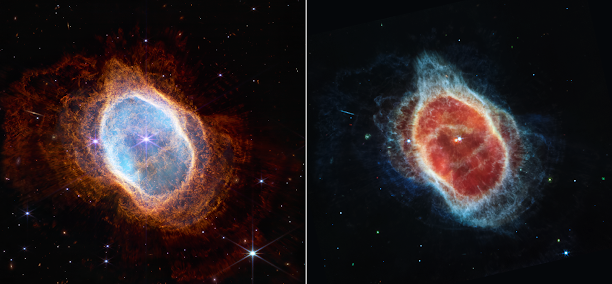 |
| Credits: NASA, ESA, CSA, and STScI. |
- Carina Nebula - Webb proved its worth when it zoomed into the Carina Nebula (NGC 3372), located almost 8,500 light-years away in the southern constellation of Carina. In the "Cosmic Cliffs", named so because of the dramatic flow of gas, astronomers have discovered scores of young hot stars in different stages of stellar evolution.
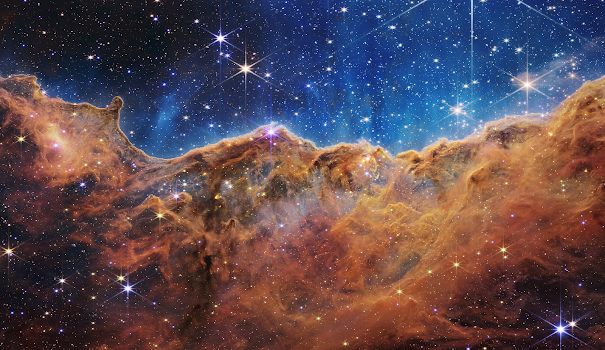 |
| Credits: NASA, ESA, CSA, and STScI. |
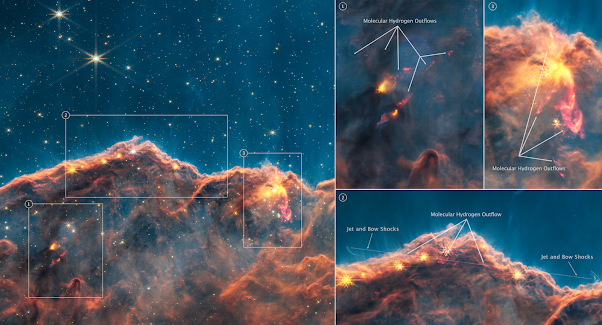 |
| NASA'S Webb Unveils Young Stars in Early Stages of Formation Credits: NASA, ESA, CSA, and STScI. |
- Stephan's Quintet - Looking into the constellation of Pegasus in the northern sky, Webb glances upon Stephan's Quintet. NGC 7320, the large galaxy to the left, lies separate from what is known as the Hickson Compact Group. The four galaxies to the right, NGC 7319, 7318 a and b, and 7317, are in the process of merging into one.
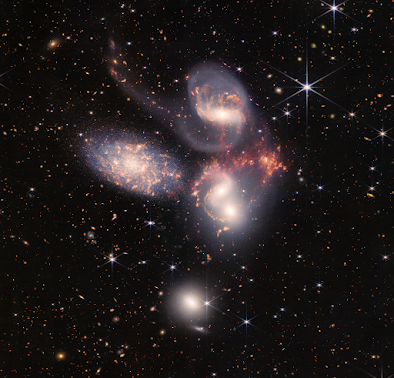 |
| Credits: NASA, CSA, ESA, STScI. |
- WASP-96b - Webb finishes its first run of observations with the spectra (transmission spectrum) of exoplanet WASP-96b and its light curve. 1,150 light-years away in the constellation of Phoenix, WASP-96b is a hot gas giant exoplanet with an atmospheric temperature likely in the range of 700℃. Orbiting a sun-like star, WASP-96b, weighs close to 0.48 times that of Jupiter.
 |
| Credits: NASA, ESA, CSA, STScI. |
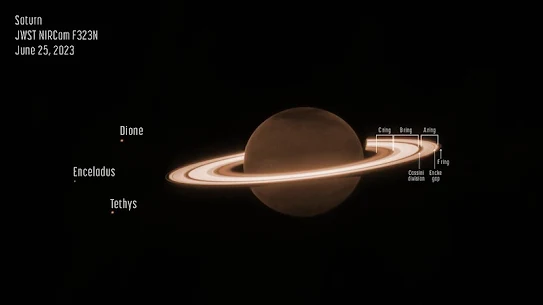 |
| NASA Page: Saturn's Rings Shine in Webb's Observations of Ringed Planet. Credits: NASA, ESA, CSA, STScI. |
 |
| NASA Page: Webb, Keck Telescopes Team Up to Track Clouds on Saturn's Moon Titan. Credits: NASA, CSA, ESA, and STScI. |
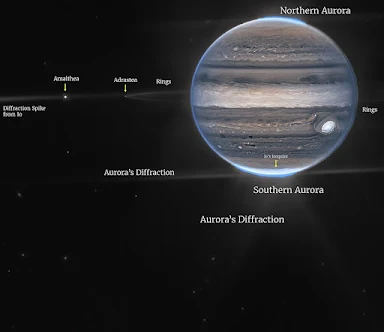 |
| NASA Page: Webb's Jupiter Images Showcase Auroras, Hazes Credits: NASA, ESA, CSA and STScI. |
 |
| Credits: NASA, ESA, CSA, STScI. |
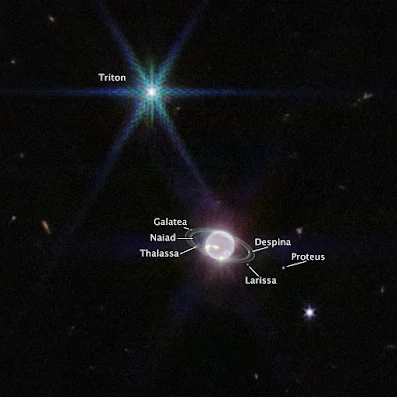 |
| NASA Page: New Webb Image Captures Clearest View of Neptune's Rings in Decades Credits: NASA, ESA, CSA, STScI. |
 |
| Comparison between Voyager 2, Hubble, and Webb. Credits: NASA, ESA, CSA, and STScI. |
Uranus and its moons :
 |
| NASA Page: New Webb Scores Another Ringed World with New New Image of Uranus Credits: NASA, ESA, CSA and STScI. |
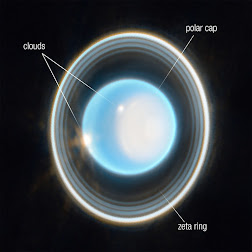 |
| Credits: NASA, ESA, CSA, and STScI. |
At Extragalactic Scales:
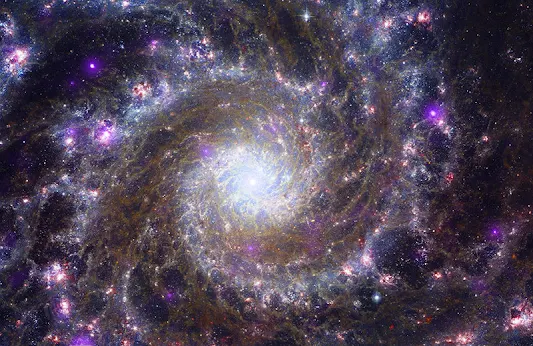 |
| Phantom Galaxy. X-ray, infrared, and optical data combined from Chandra, Webb, and Hubble. Designated as M74, the Pinwheel galaxy, a large spiral galaxy, is located about 32 million light-years from Earth in the equatorial constellation of Pisces. The details in this image are stunning. NASA Page |
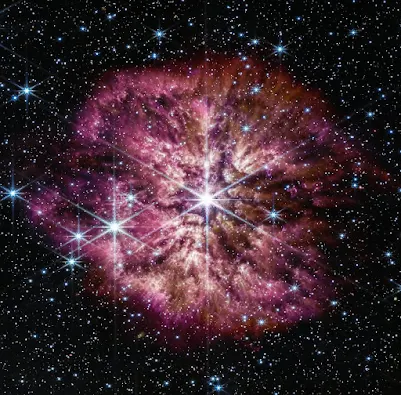 |
| WR 124. Located in the northern constellation of Sagitta and 21,000 light-years away from Earth. Wolf Rayet stars, weighing anywhere from 10 - 50 solar masses, are massive stars that have completely shed their outer layers of hydrogen and are fusing helium or other heavier elements in their core. NASA Page |
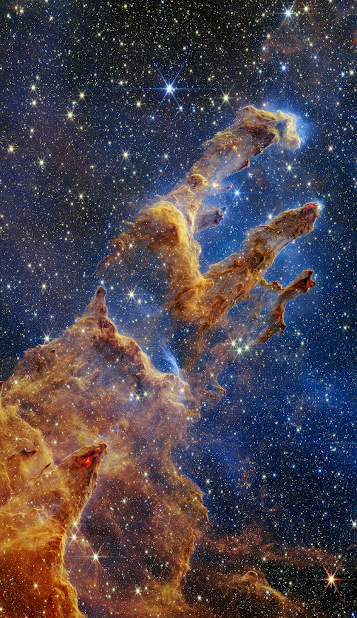 |
| Pillars of Creation in the Eagle Nebula. 5,700 light-years distant in the constellation of Serpens. NASA Page |
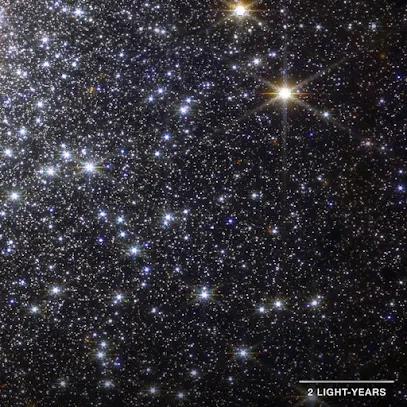 |
| No number of stars is too many. M92 globular cluster in the Northern Constellation of Hercules. NASA Page |
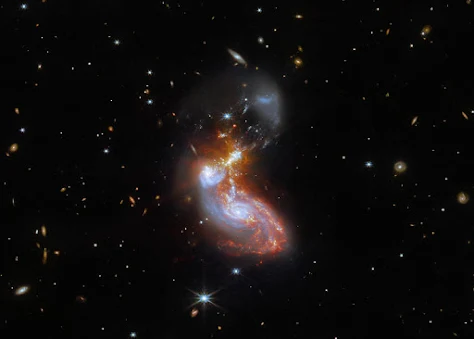 |
| Coming in closer. II ZW 96. A pair of colliding galaxies. NASA Page |
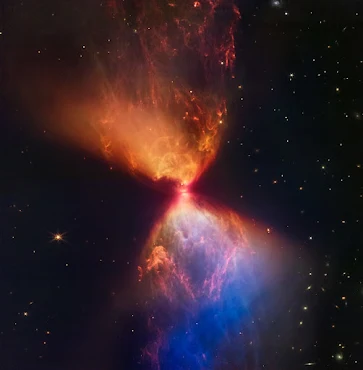 |
| A new star forms. The protostar remains obscured from view in the dark nebula L1527. As material feeds the nascent star, the nebula looks like an hourglass. NASA Page |
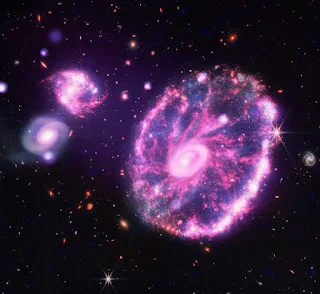 |
| Cartwheel Galaxy. Composite of Webb's infrared data and Chandra's x-ray. NASA Page |
This is only the beginning, though. In the coming years, Webb will surpass all of our expectations and take us to places forever beyond our physical reach. We are still a long way from settling on the Moon. If we can return to the Moon in 2025, provided the Artemis mission goes as planned, this will be the second time we will have our presence on a world other than Earth since the last Apollo 17 mission in 1972. A manned mission to Mars is still out of bounds. Venturing out to the outer solar system may take a hundred years. Space is vast, and we are tiny. Our insignificance becomes excruciatingly painful when we look at the Pale Blue Dot, a photograph of Earth taken on February 14, 1990, by the Voyager 1 spacecraft from a distance of 6 billion km. Compared to cosmic scales, 6 billion km is nothing. At such distances our planet appears inconspicuous as a point of pale light lost in the glare of the Sun. At even greater, extragalactic distances, the entire solar system shrinks to a point. Earth is where we stand. The Pale Blue Dot is where we will be for eons to come.


Comments
Post a Comment